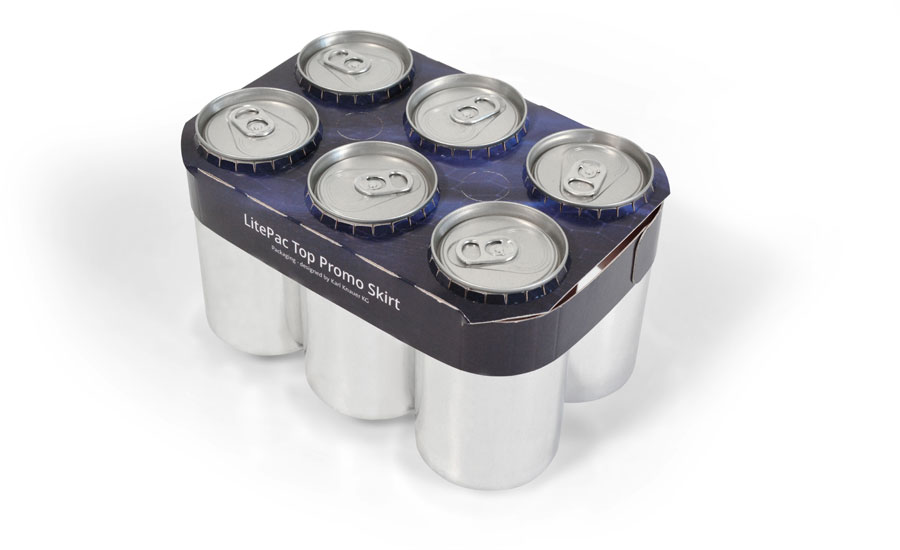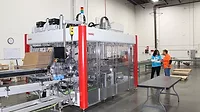Packaging Equipment
Changeovers, shrinking workforce influence case packers and wrappers
Sustainable secondary, tertiary packaging impacting machinery

The nonprofit World Juggling Federation (WJF) recently hosted the 2022 Ball Short Program where competitors showcased not just the number of balls they can juggle, but also the movement skills that add another layer of entertainment to the craft. The juggling seen from the WJF is meant to entertain, but the juggling that beverage packing operations are navigating are a necessity as SKU proliferation and varying pack sizes have prompted the need for flexible equipment.
“Flexibility is having a major impact on case packing and wrapping equipment, as secondary packaging decisions can change quickly as the package design is driven through marketing and customer acceptance,” says Wolfgang Huber, head of order center and assembly of packaging technology at Krones AG, Neutraubling, Germany. “Packaging machinery must be flexible in order to respond to these decisions.”
Huber notes this need for flexibility comes as variety packs have seen increased demands.
“What we have seen in the last years is an increase in multi-flavor packs requested from the market,” he says. “Also, the trend toward more healthy products influences the design and material of the secondary packaging.”
Maria Cancino, product line manager at Alexandria, Minn.-based Brenton, a ProMach company, echoes similar sentiments.
“Traditionally, wrap around case packing and tray shrink applications in the beverage market have focused on packing or wrapping the same format at the highest output speed possible,” Cancino says. “As the market has moved to specialty flavors, specialty drinks, and club/store package exclusives, there is a large need to also handle multiple SKUs or pack patterns on the same line at a slightly slower speed.
“The focus for these lines has moved from a concentration on the fastest speed and highest output to having end of line automation that can handle a variety of SKUs and pack patterns within the same machine,” she continues.
Cancino explains how flexibility demands is prompting original equipment manufacturers (OEMs) of automated packers to focus on reducing changeover times.
“From a case packing or shrink wrapping perspective, our changeover process needs to take less time than the changeover at the filler and preferably only takes the same number of operators as it does to run the machine,” she notes.

Image courtesy of Krones AG
At Pack Expo International, Brenton demonstrated its M3000 Case Packer, which is designed to fill a need for mid-range manufacturers of packaged personal care and food products to pack as many as 50 wrap-around or tray-style cases a minute, the company says. The machine features Brenton’s standard servo-driven changeover assist design for faster, more consistent changeovers in 15 minutes or less with minimal manual adjustments, it adds.
The sustainable factor
Yet, flexibility is not the only trend having an impact on packing operations. Suppliers note that the demand from beverage-makers as well as consumers has prompted the need for more sustainable secondary packaging.
“Sustainability efforts have impacted case packing and shrink wrapping or bundling equipment from both the product to be packed/wrapped to the material used to pack or wrap the product,” Cancino says. “From a product perspective, we have seen the change in materials containing beverages to entirely new materials causing changes in the bottle walls or bottle shapes.
“Sometime making it easier others more difficult to handle the bottles and ultimate pack or wrap them,” she continues. “Sustainability has also driven the use of recycled corrugate and compostable films driving change in the case / tray packing and shrink bundling equipment to handle the new characteristics of the recycled corrugate or compostable film.”
Krones’ Huber explains that the supplier also has seen increased interest for sustainable secondary packaging and is addressing it with LitePac Top.
“This impact is huge. Sustainability is the number one topic for our customers from a global perspective,” he says. “Due to legislation in certain local governments, they need to come up with more sustainable secondary packaging solutions, such as plastic-free secondary packaging like our LitePac Top.”
LitePac Top is a packaging solution comprising a bottle carrier and possibly other pack securing, such as a banderole. The company adds that the secondary packaging offering is suitable for non-returnable PET bottles and cans, and also is a sustainable alternative to shrink film packs.
In terms of machinery, Krones packers Variopac Pro modular machine component system can create secondary and tertiary packaging on one machine. The technology also can be easily integrated in existing lines, the company says.
Evolving operations
As suppliers streamline machinery for today’s beverage packing needs, experts note that operations managers must also keep an eye on the evolution of the workforce.
“The changing workforce affects the beverage market as it does the market as a whole,” Brenton’s Cancino says. “With less skilled labor available, we see the loss of tribal knowledge to be able to trouble shoot and maintain automation equipment. To counteract this trend, OEM vendors have had to make operator controls more intuitive and help the operators trouble shoot when something goes wrong.”
This coupled with SKU proliferation highlights the need for automation within beverage manufacturing facilities.
“In the past, ROI would have been calculated by the number of labor hours saved and how that translates to workforce reduction,” Cancino says. “In this new world, the opportunity cost of not running the line needs to be included in that evaluation. Changing the evaluation to the capability of shipping product due to automation versus the line sitting idle until enough people are hired to run it, can be the difference between investing in automation and putting the project on hold.
“It also means the automation partner selection process is just as important as the actual equipment purchased,” she continues. “The vendor is more than just a transactional partner, but a trusted advisor that can help to advocate a solution that matches the application.”
Looking for a reprint of this article?
From high-res PDFs to custom plaques, order your copy today!





